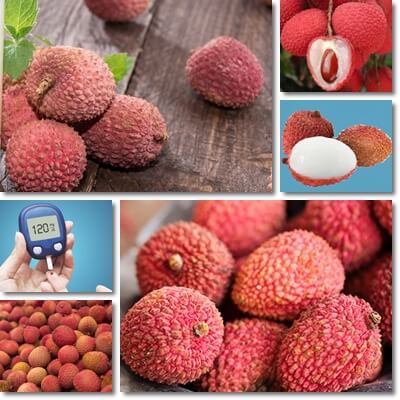Lychee is not considered one of the best fruits for diabetes because of its relatively high sugar content. Yet, as a diabetic, you can eat the fresh fruit with your condition, just in small amounts. Keeping to small portions means getting limited amounts of carbohydrates to fuel the rise in blood sugar which translates into a steady, more manageable rise. The average glycemic index of fresh lychee fruits is 60, a moderate score which doesn’t necessarily recommend them for consumption with diabetes. But, if eaten in small amounts, preferably not every single day, lychee can be well tolerated in a diabetic diet.
What is the glycemic index of lychee?
The glycemic index, GI for short, is a scale that measures how fast the carbohydrates in a food raise blood sugar levels. Between 0- 55 is a low GI. Between 56-69 is a moderate GI. Between 70-100 is a high GI. The lower the GI score of a food, the lesser the effects of said food on blood sugar. The higher the GI, the more pregnant the effects. Diabetics and anyone looking to control their blood sugar are better off choosing foods with as low a GI as possible as often and possible and avoiding high-GI foods to the best of their efforts.

Fresh lychee glycemic index varies from low to high. Depending on variety and nutritional profile of individual fruits, lychee glycemic index may range from less than 50 to 70 and higher, with an average GI score of 60. What this means is that, while some fruits are low-GI and some high-GI, for the most part, lychee is moderate-glycemic. Still, diabetics can eat fresh lychee with their condition, but only in moderation. Eating too much of at once has the potential to make blood sugar go up fast, but sticking to small amounts should be fine.
Dried lychee glycemic index is undetermined, but presumed to be high. Compared to the fresh fruit which only has 16.5 g of cars of which 15.23 g are sugars, the dried fruit has over 70 g of carbs of which 66 g are sugars (values for 100 g of fruit). Considering it is naturally high in sugar, dried lychee cannot be low on the GI scale, or even moderate for that matter.
What is the glycemic load of lychee?
The glycemic load, GL for short, is a scale that measures how fast the carbohydrates in a serving of a food raise blood sugar levels. Between 0-10 is a low GL. Between 11-19 is a moderate GL. Over 20 is a high GL. The glycemic load for fresh lychee is 5 (for a serving of 5 fruits without peel and seed), 10 (for a serving of 10 fruits without peel and seed), also 10 (for a serving of 100 g of the fruit). But a cup of the fruit at 190 g has a GL of 19, which is high. If you have diabetes, know that you can eat fresh lychee with your condition and not experience spikes in blood sugar so long as you restrict intake to small amounts of 100 g and lower (up to about 10 fruits per serving).

Lychee blood sugar effects
Lychee and diabetes make a good pair so long as the fruit is consumed in small amounts (small portions). Lychee is naturally high in sugar, with 15.23 g of sugar out of a total of 16.53 g of carbs (the rest of 1.3 g of carbs is made of indigestible dietary fiber). Essentially, all the digestible carbohydrates in the fresh fruit are sugars. So, needless to say, eating it does raise blood sugar levels, whether you have diabetes or not. But the extent to which it does depends on how much of the fruit you have at once. The less lychee you eat at once, the lesser the effects on blood sugar. The more you eat at once, the more pregnant the effects.
How to eat lychee with diabetes
If you have diabetes but are looking to introduce fresh lychee into your diet, it may help to know how to reduce the effects of the fruit on blood sugar and make it safer to eat with your condition.
1) Eat small amounts at once. Start with smaller portion sizes and adjust your intake according to your glycemic response.
2) One serving of lychee a day is enough. Keep your diet varied by eating other fruits too.
3) Because it’s a moderate and, sometimes, high-glycemic fruit, lychee is best not eaten every single day.
4) Not on an empty stomach. Have the fruit after a meal low in carbs that provides lean protein and some fat too. This way, you reduce the glycemic effects.
5) Don’t pair fruit with fruit, especially not moderate to high-glycemic ones. Instead, pair them with lean protein or fat from nuts, seeds, a little cheese, meat or eggs.
6) Consider how eating lychee affects you as an individual and decide if you should eat it at all and in what amounts.
7) Always choose the fresh fruit over dried options and remember that the peel and seed are inedible.
Lychee nutrition facts and benefits for diabetes
The fresh fruit is a significant source of carbohydrates (16.53 g per 100 g), most of which are sugars (15.23 g) and very little dietary fiber to offset the glycemic effects of the carbohydrates (1.3 g). Lychees have less than 0.5% fat and less than 1% protein so there’s nothing here either to balance the carbohydrates. As a result, the fruit is best eaten in moderation, especially with diabetes.
But how is lychee good for diabetics? If eaten in reasonable amounts, small portions at a time, lychee benefits various aspects of diabetic health. The fresh fruit is high in vitamin C (71.5 mg per 100 g) which helps with faster wound healing by supporting the production of collagen and exerting anti-inflammatory and especially antibacterial effects. It is also a varied source of B vitamins, with less than 10% of the recommended daily intake of vitamin B6 and 5% and less of vitamins B1, B2, B3 and B9. B vitamins hold benefits for diabetes-associated nerve damage. Small amounts of magnesium (10 mg per 100 g) and dietary fiber (1.3 g) hold minor benefits for blood sugar control, whereas magnesium and potassium (171 mg per 100 g) are good for diabetes-associated high blood pressure.
